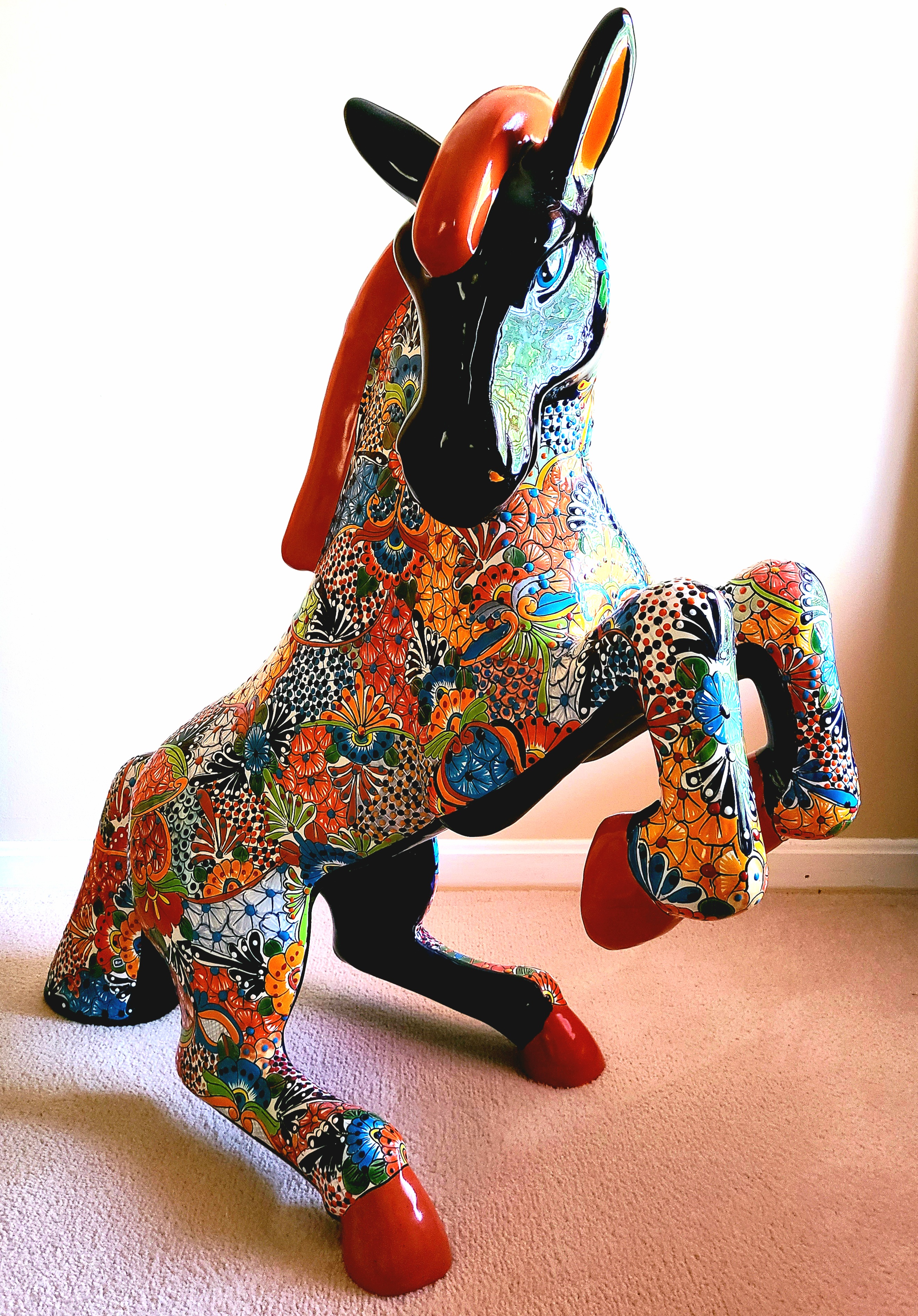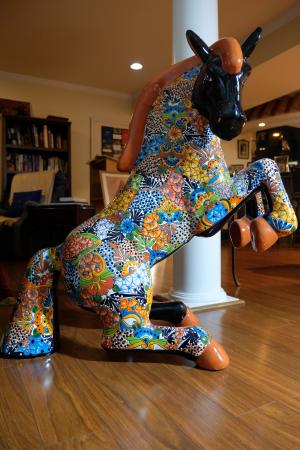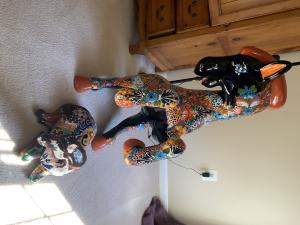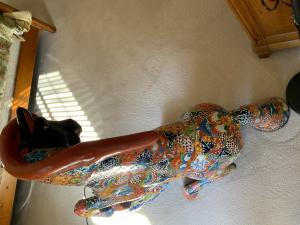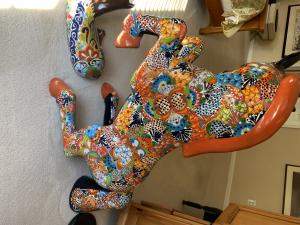Talavera Horse
unknown
Ceramics
Colorful multi-patterned ceramic horse created in the Talavera pottery style which blends indigenous and European artistry. Talavera pottery was introduced in Puebla, Mexico by immigrants from Talavera de la Reina, Spain, and has remained a Mexican tradition for centuries. See below for more information on the Talavera style.
Today, true, certified Talavera pottery is produced in the city of Puebla, in the state of Puebla, Mexico. However, high-quality, modern Talavera pottery is also available from factories in other Mexican districts such as Dolores Hidalgo and Guanajuato. The age-old techniques have been passed down from generation to generation by master craftsmen. There were ordinances set for all potters wanting to create in the Talavera style to ensure uniformity and the continuance of the distinctive style and excellence. Some of the ordinances in place include:
• Blue was to be used on the finest ceramics as the mineral pigments needed to produce this color was very expensive. During the 18th century, the Talavera artisans started to broaden the designs of their ceramic by using more colors, like green, mauve, and yellow, in addition to the blue tones that were very popular in the 16th and 17th Centuries.
• To avoid the production of fake Talavera, each master potter was required to sign or mark his products with their specific and registered mark. Certified Talavera pieces bear the signature of the potter, the logo of the workshop, and a special governmental hologram that certifies the piece’s authenticity. Only pieces from government-approved workshops that meet the standards are certified and considered authentic Talavera. *see below for today’s standards for certification*
• Three types of earthenware were to be produced depending on the quality of the pieces: Fine, Semi fine, and for Daily use
Some of these ordinances are still followed by today Talavera artisans. The Talavera produced in certain workshops in Puebla is now officially designated, recognized and protected by the Government of Mexico. These Talavera manufacturers must follow a complex and strict technical fabrication process dating from the 16th Century and use only clay from a few approved clay sites in the Puebla area.
As of 2020, the Talavera Regulatory Council (CRT) represents nine Talavera certified producers: Uriarte Talavera, Talavera La Reyna, Talavera Armando, Talavera Celia, Talavera Santa Catarina, Talavera de la Nueva España, Talavera de la Luz, Talavera de las Americas, and Talavera Virglio Perez. Each workshop is made up of various potters whose style is distinguished by the detail in decoration, use of colors, and shapes adopted by the workshop they belong to. The oldest workshop, Uriarte Talavera, was founded in 1824 by Dimas Uriarte, and continues to produce their characteristic traditional colonial-era designs.
• Blue was to be used on the finest ceramics as the mineral pigments needed to produce this color was very expensive. During the 18th century, the Talavera artisans started to broaden the designs of their ceramic by using more colors, like green, mauve, and yellow, in addition to the blue tones that were very popular in the 16th and 17th Centuries.
• To avoid the production of fake Talavera, each master potter was required to sign or mark his products with their specific and registered mark. Certified Talavera pieces bear the signature of the potter, the logo of the workshop, and a special governmental hologram that certifies the piece’s authenticity. Only pieces from government-approved workshops that meet the standards are certified and considered authentic Talavera. *see below for today’s standards for certification*
• Three types of earthenware were to be produced depending on the quality of the pieces: Fine, Semi fine, and for Daily use
Some of these ordinances are still followed by today Talavera artisans. The Talavera produced in certain workshops in Puebla is now officially designated, recognized and protected by the Government of Mexico. These Talavera manufacturers must follow a complex and strict technical fabrication process dating from the 16th Century and use only clay from a few approved clay sites in the Puebla area.
As of 2020, the Talavera Regulatory Council (CRT) represents nine Talavera certified producers: Uriarte Talavera, Talavera La Reyna, Talavera Armando, Talavera Celia, Talavera Santa Catarina, Talavera de la Nueva España, Talavera de la Luz, Talavera de las Americas, and Talavera Virglio Perez. Each workshop is made up of various potters whose style is distinguished by the detail in decoration, use of colors, and shapes adopted by the workshop they belong to. The oldest workshop, Uriarte Talavera, was founded in 1824 by Dimas Uriarte, and continues to produce their characteristic traditional colonial-era designs.
Height: 38
Width: 17
Depth: 34
Cave Creek, Arizona
possibly Puebla, Mexico or Guanajuato, Mexico
Talavera style belongs to a larger category of Majolica ceramics, handmade and hand-painted earthenware. It is fired at extremely high temperatures producing a very durable product. Artisans are not limited to the production of tiles and vases and by the early 1900s, they started creating create plates, jars, pots, religious figures, animals, and more. Talavera is distinguished from other majolica styles by its use of natural clays, strong colorful motifs applied to a white background.
Some characteristics of genuine Talavera pottery include:
• Talavera is made from a mixture of only two clays, dark clay, and a light, slightly rose-colored clay.
• The source of clay supply to make the Talavera comes from the Talavera geographic zone of Puebla and the communities of Atlixco, Cholula and Tecali.
• Talavera is hand-formed with a potter’s wheel or using molds, not poured. They are also hand-painted.
• Talavera pieces have gone through two firings. The oven used to fire Talavera should be at least 800 degrees Celsius.
• Talavera uses six color pigments, and its color combination enhances the workmanship sophistication of Talavera pieces.
